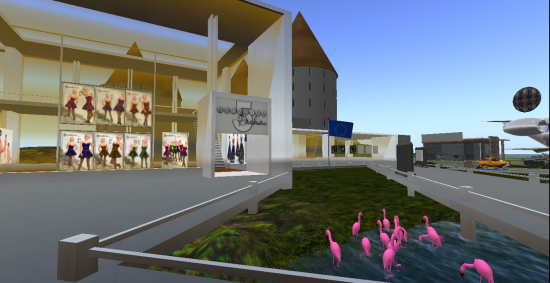Any grid owner that makes a living by renting out premium residential regions should start planning ahead — for a future in which the effective of residential regions drops down to zero.
Free is already here
Of course, there is nothing new about free regions. OSGrid and other open grids allow users to connect regions that they run at home, on their own computers.
There are disadvantages to home-based regions, however. With a typical DSL or cable connection, they can’t support more than a handful of simultaneous visitors — fewer, if the region is heavily built up. In addition, users have to take care of their own backups and upgrades.
Users also have to figure out how to connect up their regions, which often requires changing firewall settings and forwarding ports.

Finally, home-based region owners have to make sure that the computers running their regions are up around the clock — otherwise, visitors won’t be able to access their regions.
Even despite these disadvantages, however, home-based regions are popular with tech-savvy OpenSim users, and helped make OSGrid the largest grid running on OpenSim.
But competing against these kinds of free regions is easy. Plenty of people are willing to pay extra not to have to figure out how to run an OpenSim console, to be able to handle lots of visitors, or simply for the peace of mind it brings to know that a professional is taking care of backups and upgrades.
Almost-free regions
Then there are the companies offering regions that are almost free. For regions infrequently visited, there’s Kitely, where on-demand regions are just 10 cents a month, plus another 20 cents per visitor per hour. And Nova (formerly New Voice) offers full regions for just  $9.90 a month – read more about what you get for this price.
More expensive hosting providers compete against these prices by marketing their robust communities, exclusive content, personal support, in-world economies, and other premium features.
Soon, that won’t be enough.
How we’ll get there
Website hosting prices dropped naturally, as bandwidth improved, storage got cheaper, and computers got faster.
All three of these factors will drive OpenSim prices down as well.
Now, let’s do some math.
Say that the minimum hosting cost of a region today is $10 per month for a low-use, residential-style region. How often is that region going to be visited? The average user spends ten hours a week in Second Life (as per the latest Nielsen ratings) — a total of 40 hours  a month. And how many of those hours will be spent on the home region, instead of at clubs, shops, museums, nude beaches, or other social destinations? Let’s say the user spends a quarter of their time at home. That’s 10 hours of active use a month for that region. If the grid owner sticks the region into storage when it’s not used, the way Kitely does, that drops the cost per user to a little over 10 cents a month.
That’s 10 cents a month for a residential region that’s only activated when needed. With current technology.
It might as well be free already. After all, if a region owner is spending 40 hours a month on a grid, they’re bound to be dropping money somewhere. They’ll need a house to put on their region. Furniture. Landscaping. Then, for when they go out, clothes and accessories. Plus the food for their virtual pets. Club admission. Donations to good causes. Grid owners take a cut of all of these transactions. Pretty soon, you’ve got your ten cents and hosting is covered — and everything over that is just gravy.
OpenSim grid owners can easily impose zoning, so that in-world payments can only occur on commercial sims, so that the merchants and club owners pay for their hosting. And the more residents a grid has, the more it can charge for commercial land. It’s a virtuous cycle.

Meanwhile, grids that charge for residential regions will find their users fleeing to other grids where they can get land for free — and once the users are gone, the merchants and clubs will vanish, as well.
And that’s just with bootstrapped grids.
If a grid has investors, they can simply pick up the cost of 10 cents a month per customer, watch their competitors go out of business, and wait until prices drop even further before they begin monetizing the avatars.
The fallout
Say there’s a grid startup working away in a garage somewhere right now that launches a free land grid tomorrow.
(Given how fast OpenSim has been evolving lately, that’s actually a pretty likely assumption.)
A free land model would significantly impact all commercial hosting operators, especially those that were slow to adapt to the new pricing structure.
The erosion of land in Second Life would accelerate — and charging users more for premium accounts isn’t going to be much help here.
Commercial grids with a strong focus on in-world merchants and content creators would probably see a delayed hit, as merchants wait for the new freemium grids to build up a sizable population base — and prove they can protect content — before migrating over.
Eventually, all grids will either have to match the new price structure, offer features that the freemium grids don’t have, or settle for a marginalized, niche existence — if they continue to exist at all.
I know of webhosting companies that still charge small business by the page for their webhosting — with additional charges each time a change is made. And there are still folks who pay their AOL subscriptions each month even though they have broadband and no longer need it. So I’m sure there will still be some segment of the public willing to overpay for virtual land. That’s a small and shrinking user category, however — nothing to base a growing business on.
How to prepare
First, every grid owner should be keeping an eye on technology that would enable them to also offer free regions, once the time comes. It doesn’t mean that everyone will have to build this from scratch. Vendors that offer grid management tools — such as PioneerX Estates or Dreamland Metaverse — are already working on this technology.
It’s an area that I am keeping a close eye on.
Second, grid owners and hosting providers should keep an eye out for things that they can offer that a free hosting provider can’t. For example, anyone can set up a free blog with Blogger.com or any of hundreds free alternatives, but you’re stuck with their templates and their domain names. Paid hosting offers a much broader choice of site layouts, full customization ability, and a custom domain name, shopping carts, and other features.
What can commercial hosting companies offer that free ones can’t? Private grids and mini-grids are one obvious answer — there are plenty of organizations — and people — who’d want to be able to have their own grid and name it anything they want.
Depending on how free hosting evolves, there might be severe limits on prims, or scripts, or terrains with the free regions.
Commercial hosting companies should be ready to quickly change their marketing and positioning to reflect the benefits they offer compared to a free hosting model.
Finally, hosting companies should be ready to look at alternate revenue sources. such as shop rentals, virtual currencies, private-label virtual goods and partnerships with content providers.
For example, a grid could exclusively partner with a virtual pets company, putting key scripts into a server-side module inaccessible to end users. The pets would only be functional on that one grid, offering the virtual pets vendor a highly secure distribution platform — and profit-sharing for the grid owner.
- OSgrid back online after extended maintenance - April 16, 2025
- Analysts predict drop in headset sales this year - March 25, 2025
- OSgrid enters immediate long-term maintenance - March 5, 2025
